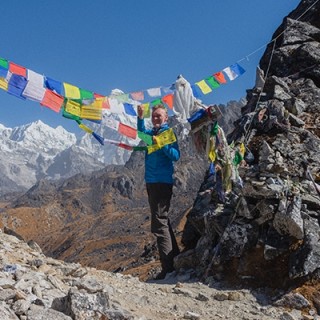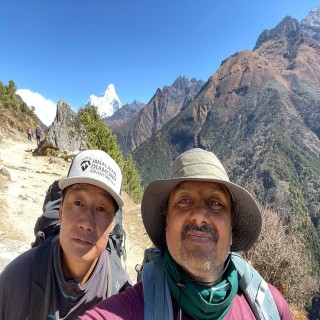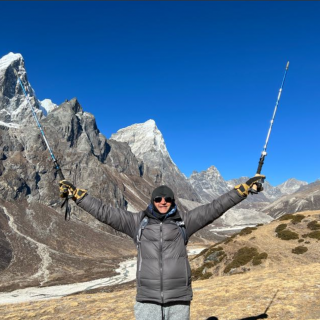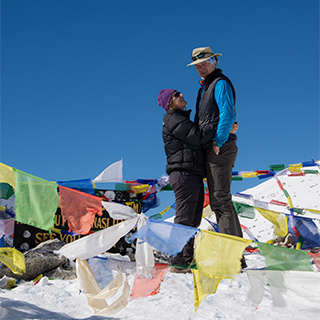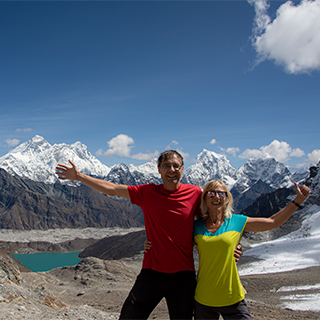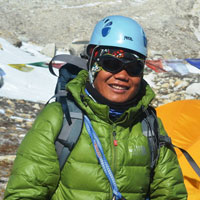Altitude sickness is a condition that occurs when you are exposed to high elevations over a short period of time. It is common among people who travel and quickly ascend to higher altitudes, either by climbing or transportation. As you climb higher, the air pressure and oxygen levels decrease, and your body needs time to adjust. To prevent altitude sickness, here are some steps you can take
Climb slowly
Your body needs 2-3 days of acclimation at high altitudes to adjust to the changes in atmospheric conditions. To avoid altitude sickness, it's best to avoid flying or driving directly to high elevations. Instead, take a gradual ascent, with daily stops to rest. If you must fly or drive, spend at least 24 hours at a lower elevation before reaching your final destination. When traveling on foot, plan your trip to include stops at lower elevations before reaching your final destination. Limit your daily ascent to no more than 1,000 feet and take a rest day for every 3,000 feet gained in elevation.
Eat carbs
You don't often hear advice to eat extra carbohydrates, but when you're at high altitudes, your body requires more energy. To stay nourished, pack plenty of healthy snacks, including a variety of whole grains, to ensure you have enough calories to keep up with the demands of your body.
Avoid alcohol
Alcohol, smoking, and certain medications, such as sleeping pills, can exacerbate the symptoms of altitude sickness. To reduce the risk of altitude sickness, it is recommended to avoid consuming alcohol, smoking, or taking sleeping pills during your trip to high elevations. If you choose to drink alcohol, wait at least 48 hours after arriving at high altitude to allow your body to acclimate before consuming alcohol.
Drink water
Staying hydrated is essential in preventing altitude sickness. Make sure to drink plenty of water regularly throughout your climb to maintain hydration.
Take it easy
When climbing to high altitudes, it's important to go at a pace that is comfortable for you. Avoid pushing yourself too hard or engaging in strenuous physical activity that could strain your bod
Sleep at lower Altitude
Altitude sickness can often become more severe at night, especially when you're sleeping. To reduce the risk of altitude sickness, it's recommended to make daily ascents during the day and return to a lower elevation to sleep, especially if you plan to climb more than 1,000 feet in a single day.
Medication
Medications are not typically prescribed unless it's unavoidable to travel by air or drive, hike, or climb to high elevations. However, some studies suggest that taking Acetazolamide (formerly known as Diamox) two days prior to your trip and during the trip can help reduce the risk of altitude sickness.
Altitude sickness.
Acetazolamide, originally used to treat glaucoma, can also aid in preventing altitude sickness. A prescription from a doctor is required to obtain it. However, it's important to note that taking Acetazolamide does not guarantee immunity to altitude sickness. If symptoms do occur, the medication will not alleviate them. The most effective and reliable treatment for altitude sickness is to descend to a lower elevation.
Some Vital Keys to prevent Acute Mountain Sickness...........................................
****Climb the mountain gradually, pack a light daypack, and drink plenty of water.
****After reaching the campsite, change into dry clothes immediately.
****Limit daily ascents to 485 meters when above 2,400 meters.
****Go high but sleep at a lower altitude when possible.
****Avoid Alcohol, smoking,
****Eat extra carbohydrates
****If you experience moderate altitude sickness, stop climbing and wait for improvement. If there is no improvement, descend and seek treatment.
****If you have severe altitude sickness (symptoms include persistent vomiting, headache, fatigue, confusion, rapid breathing, coughing pinkish sputum, rapid heart rate, blue lips and face, and low urine output), descend immediately by 600m to 1000m and use oxygen if available. If oxygen is not available, seek help from a strong person, helicopter, doctor, or rescue team, and avoid exertion.
Rest for a day or two every 2,000 feet (600 meters) while climbing above 8,000 feet (2,400 meters).
Learn how to recognize early symptoms of mountain sickness.
Alternative Names................................
High altitude cerebral edema; Altitude anoxia; Altitude sickness; Mountain sickness; High altitude pulmonary edema.
Symptoms of Altitude Sickness
Mild symptoms include............................................................................
****Not feeling well overall.
****Trouble sleeping.
****Loss of appetite.
If you experience mild altitude sickness, descend to a lower elevation. Symptoms will subside on their own. After a few days of rest, you can continue the trip.
Severe symptoms include............................................................
****More intense versions of the mild symptoms.
****Feeling out of breath, even when you’re resting.
****Coughing that won’t stop.
****Tightness in the chest.
****Congestion in the chest or causing difficulties:
****Trouble walking.
****Seeing double.
****Confusion.
****Skin color changing to gray, blue, or paler than normal.
Severe altitude sickness can be life-threatening with symptoms like fluid buildup in lungs and brain. If experienced, immediately descend and seek medical help.
Bottom Line
Everyone reacts differently to high altitudes, making it difficult to predict symptoms. To avoid altitude sickness, ascend gradually and prepare using recommended tips. If you have pre-existing medical conditions, consult your doctor before traveling to high altitudes as they may worsen symptoms.
Symptoms of HAPE:
Symptoms of HAPE include shortness of breath, fatigue, and rapid heartbeat. If HAPE develops, prompt treatment by decreasing altitude or using oxygen is necessary.
Acute mountain sickness can lead to HAPE (high-altitude pulmonary edema) with breathing difficulties or HACE (high-altitude cerebral edema) with confusion. Chronic mountain sickness can result from prolonged exposure to high altitudes.
Symptoms of HAPE include:
Common symptoms of HACE are confusion, unconsciousness, fever, hallucinations, delirium, rapid heartbeat, fatigue, and altered mental state. Untreated HAPE can be fatal if altitude is not decreased or oxygen is not administered promptly.
What Causes Altitude Sickness?
Altitude sickness can occur if your body fails to acclimate to high elevations where air becomes thinner and less oxygen-rich. It's most common at elevations above 2,438 meters (8,000 ft), affecting 20% of hikers, skiers, and travelers. This increases to 50% at elevations above 5,486 meters (18,000 ft).
Keys Causes
Acute mountain sickness is caused by low air pressure and reduced oxygen levels at high altitudes. Rapid ascent increases the likelihood of getting the illness.
You are at higher risk for acute mountain sickness if you:
****Live at low or near sea level and travel to high altitude
****Have had the illness previously.
Who is at risk for Altitude Sickness?
Your risk of altitude sickness is low if:.............................
****You've had no previous episodes
****You gradually increase altitude
Risk increases if:.............................................
****You have a history of altitude sickness
****You rapidly ascend, climbing more than 487m/ 1,600 feet per day.
Exams and Tests
The healthcare provider will examine you and listen to your chest with a stethoscope. They may hear crackles (rales) in the lungs, indicating fluid build-up.
****Tests may include
****Blood tests
****Brain CT scan
****Chest x-ray
****Electrocardiogram (ECG)
Treatment
Early treatment is important for acute mountain sickness. To treat it, descend 600-1000 meters to a lower altitude as soon as possible if symptoms occur
Extra oxygen should be given, if available
People with severe mountain sickness may need to be admitted to a hospital. Acetazolamide (Diamox) may be given to help with breathing difficulties. It can reduce mild symptoms, but may also cause increased urination. Ensure to drink sufficient fluids and avoid alcohol while taking this medication, which is most effective when taken before reaching high altitudes.
If you have fluid in your lungs (pulmonary edema), treatment may include.
Headache; (Paracetamol, Aspirin)
Severe headache; (Code Ine)
Nausea; (Compazine)
Acute Mountain Sickness; (Diamax 250mg) 2 times
If symptoms are moderate or severe; (Dezamethazone, Oxygen,)
A high blood pressure medicine; (Nifedipine, Adalat 20mg) Every in 6hrs
Beta agonist inhalers; to open the airways
Breathing machine in severe cases
High Altitude Pulmonary Edema; (PAC bag) Portable Hyperbaric Chamber
Cerebral Edema; (Dexamethasone, Decadron) may help to reduce swelling the brain
Medicine to increase blood flow to the lungs; phosphodiesterase inhibitor (such as sildenafil)
Portable hyperbaric chambers (PAC bags) allow hikers to simulate conditions at lower altitudes without actually moving from their location on the mountain. These devices are very helpful if bad weather or other factors make climbing down the mountain impossible.
Outlook (prediction)
Most cases are mild and symptoms improve quickly when you descend to a lower altitude.
Severe cases may lead to death due to lung problems or brain swelling (cerebral edema).
If treatment is delayed or an emergency evacuation is not possible, the outlook may be negative.
The response to treatment can vary and some individuals may be more prone to altitude-related sickness.
Possible Complications:
Coma
Pulmonary edema (fluid in the lungs)
Cerebral edema (swelling of the brain) that can cause seizures, mental changes or permanent nervous system damage
Death
When to Contact a Medical Professional:
**********Call your doctor if you have or had symptoms of acute mountain sickness, even if they improved when you descended to a lower altitude.
*********Call emergency services or local emergency number if you or someone you're with have severe breathing problems, coughing up blood, or have HAPE/HACE.
************************If experiencing severe symptoms, descend the mountain as quickly and safely as possible.


